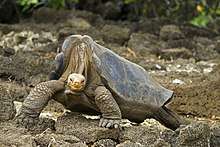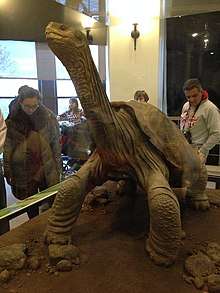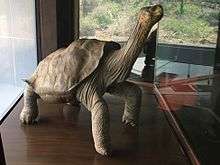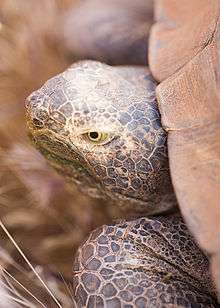Lonesome George
Lonesome George (Spanish: El Solitario Jorge; c. 1910[1][2][3][4] – June 24, 2012) was a male Pinta Island tortoise (Chelonoidis abingdonii) and the last known individual of the species.[5][6][7][8] In his last years, he was known as the rarest creature in the world. George serves as an important symbol for conservation efforts in the Galápagos Islands and throughout the world.[9]
 Lonesome George at the Charles Darwin Research Station, photograph taken in December 2006 | |
| Species | Chelonoidis abingdonii (Pinta Island tortoise) |
|---|---|
| Sex | Male |
| Hatched | c. 1910 |
| Died | June 24, 2012 (aged 101–102) Galápagos National Park |
| Resting place | Taxidermied and on display at Charles Darwin Research Station |
| Nation from | Galápagos |
| Known for | Being an endling |
| Offspring | None |
| Named after | possibly George Gobel |
Discovery
George was first seen on the island of Pinta on November 1, 1971, by Hungarian malacologist József Vágvölgyi. The island's vegetation had been devastated by introduced feral goats, and the indigenous C. abingdonii population had been reduced to a single individual. It is thought that he was named after a character played by American actor George Gobel.[10] He was relocated for his own safety to the Charles Darwin Research Station on Santa Cruz Island, where he spent his life under the care of Fausto Llerena, for whom the tortoise breeding center is named.
It was hoped that more Pinta Island tortoises would be found, either on Pinta Island or in one of the world's zoos, similar to the discovery of the Española Island male in San Diego. No other Pinta Island tortoises were found. The Pinta Island tortoise was pronounced functionally extinct, as George was in captivity.
Mating attempts

Over the decades, all attempts at mating Lonesome George had been unsuccessful. This prompted researchers at the Darwin Station to offer a $10,000 reward for a suitable mate.[5]
Until January 2011, George was penned with two females of the species Chelonoidis becki (from the Wolf Volcano region of Isabela Island), in the hope his genotype would be retained in any resulting progeny. This species was then thought to be genetically closest to George's; however, any potential offspring would have been hybrids, not purebreds of the Pinta Island species.[11]
In July 2008, George mated with one of his female companions. 13 eggs were collected and placed in incubators.[12] On November 11, 2008, the Charles Darwin Foundation reported 80% of the eggs showed weight loss characteristic of being inviable.[12][13] By December 2008, the remaining eggs had failed to hatch and X-rays showed that they were inviable.[14]
On July 23, 2009, exactly one year after announcing George had mated, the Galápagos National Park announced one of George's female companions had laid a second clutch of five eggs.[15] The park authority expressed its hope for the second clutch of eggs, which it said were in perfect condition.[16] The eggs were moved to an incubator, but on December 16, it was announced that the incubation period had ended and the eggs were inviable (as was a third batch of six eggs laid by the other female).[17]
In November 1999, scientists reported Lonesome George was "very closely related to tortoises" from Española Island (C. hoodensis) and San Cristóbal Island (C. chathamensis).[18] On January 20, 2011, two individual C. hoodensis female partners were imported to the Charles Darwin Research Station, where George lived.[19]
Death

On June 24, 2012, at 8:00 am local time, Galápagos National Park director Edwin Naula announced that Lonesome George had been found dead by Fausto Llerana, who had looked after him for 40 years.[20][21] Naula suspected that the cause of death was cardiac arrest.[22] A necropsy confirmed that George died from natural causes.[23] The body of Lonesome George was frozen and shipped to the American Museum of Natural History in New York City to be preserved by taxidermists.[24] The preservation work was carried out by the museum's taxidermist George Dante, with input from scientists.[25]

After a short display at the museum, it was expected that Lonesome George would be returned to the Galápagos and displayed at the Charles Darwin Research Station on Santa Cruz Island for future generations to see.[26] However, a dispute broke out between an Ecuadorean ministry and the Galápagos Islands. The Ecuadorean government wanted him to be shown in the capital, Quito, but the Galápagos local mayor said Lonesome George was a symbol of the islands and should return home.[27]
On February 17, 2017, Lonesome George flew back to the Galápagos Islands and is currently on display in an exhibit completely dedicated to him at the Charles Darwin Research Station.[28] Most sources state Lonesome George was more than 100 years old,[1][2][3][4] though others such as David Attenborough said he was probably in his 80s or possibly even younger.[5][29] Even 100 was not especially old for a Galápagos tortoise.[30]
Biological conservation
In November 2012, in the journal Biological Conservation, researchers reported identifying 17 tortoises that are partially descended from the same species as Lonesome George, leading them to speculate that related purebred individuals of that species may still be alive.[31]
In December 2015, it was reported that the discovery of another species, Chelonoidis donfaustoi, by Yale researchers had a 90% DNA match to that of the Pinta Island tortoise and that scientists believe this could possibly be used to resurrect the species. This could mean that he is not the last of his kind.[32][33]
In December 2018 a paper was published by Quesada et al. describing the sequencing of George's genome and some of his ageing-related genes. They estimated that the population of C. abingdonii had been declining for the past 1 million years and identified proteostasis, metabolism regulation and immune response as key processes during the evolution of giant tortoises via effects on longevity and resistance to infection.[34]
References
- Ingber, Sasha (November 16, 2012). "Lonesome George Not the Last of His Kind, After All?". National Geographic Society. Retrieved 5 June 2014.
...the 1972 discovery of Lonesome George, then around 60 years old...
- Staff. "Lonesome George". Galapagos Conservancy. Retrieved 5 June 2014.
...his age was estimated at over 100 years old at the time of his passing...
- Staff (June 2012). "The Loneliest Animals: Update: Galapagos Tortoise Lonesome George Dies". PBS. Retrieved 5 June 2014.
...about 100 at the time of his death...
- Jones, Bryony (25 June 2012). "Lonesome George, last of the Pinta Island tortoises, dies". CNN. Retrieved 26 June 2012.
- Gardner, Simon (6 February 2001). "Lonesome George faces own Galapagos tortoise curse". Archived from the original on 2011-05-24. Retrieved 2014-06-02.
- Proceso de Relaciones Públicas de la Dirección del Parque Nacional Galápagos (24 June 2012). "El mundo pierde al solitario George". Archived from the original on 28 June 2012. Retrieved 2012-06-25.
- "Lonesome George, last-of-his-kind Galapagos tortoise, dies". The Times Of India. 25 June 2012.
- Raferty, Isolde. "Lonesome George, last-of-its-kind Galapagos tortoise, dies". MSNBC. Archived from the original on 2012-06-27. Retrieved 2012-06-24.
- Nicholls, Henry (2006). Lonesome George: The Life and Loves of a Conservation Icon. London: Macmillan Science. ISBN 978-1-4039-4576-1.
- Chambers, Paul (2004). A Sheltered Life: The Unexpected History of the Giant Tortoise. Oxford University Press. p. 246. ISBN 978-0719565298.
- "Joy at giant tortoise eggs". BBC. 23 July 2008. Retrieved 2012-01-11.
- "Dwindling Hopes of Offspring from Lonesome". Charles Darwin Foundation for the Galapagos Islands. November 11, 2008. Archived from the original on 2008-12-08. Retrieved 2012-01-11.
- "Galapagos bachelor tortoise struggles to be a dad". CBC. November 11, 2008. Retrieved 2012-01-11.
- Gray, Louise (5 December 2008). "Lonesome George's first sex in decades ends in disappointment". The Telegraph. London. Retrieved 2012-01-11.
- "New eggs spark Galapagos tortoise hopes". WA Today. July 23, 2009. Retrieved 2012-01-11.
- Tran, Mark (22 July 2009). "Lonesome George, the last Galápagos giant tortoise, may become a dad". The Guardian. London. Retrieved 2012-01-11.
- "Eggs from Lonesome George's Companion are Infertile, Once Again" (Press release). Galapagos Conservancy. December 16, 2009. Archived from the original on November 8, 2010. Retrieved January 11, 2012.
- Caccone, Adalgisa; Gibbs, James P.; Ketmaier, Valerio; Suatoni, Elizabeth; Powell, Jeffrey R. (1999). "Origin and evolutionary relationships of giant Galápagos tortoises". Proceedings of the National Academy of Sciences. 96 (23): 13223–8. Bibcode:1999PNAS...9613223C. doi:10.1073/pnas.96.23.13223. JSTOR 49147. PMC 23929. PMID 10557302.
- "Will Lonesome George finally find a mate?". London: The Telegraph. January 21, 2011. Retrieved 2012-01-11.
- "Lonesome George, last of the Pinta Island tortoises, dies". CNN. 25 June 2012. Retrieved 25 June 2012.
- "Giant tortoise Lonesome George's death leaves the world one subspecies poorer". nationalpost.com. Retrieved 25 June 2012.
- "El solitario George murió esta madrugada" (in Spanish). El Comercio. 24 June 2012. Retrieved 24 June 2012.
Naula estima que el fallecimiento se debió a un paro del corazón, propio de que la tortuga ya habría cumplido su ciclo de vida. No obstante, se esperará hasta el resultado de la necropsia para determinar oficialmente qué generó el deceso.
- "Necropsia de "solitario Jorge" revela que murió de viejo". El Nuevo Dia (in Spanish). Retrieved 2017-12-18.
- Fountain, Henry (1 July 2013). "With Taxidermists' Help, Lonesome George Will Remain in Public View". The New York Times.
- "Science-Based Artist Gives Celebrity Tortoise A Second Life". 2015-03-02.
- "Tortoise Lonesome George to be embalmed". UPI. 28 June 2012. Retrieved 2012-09-16.
- "Galapagos tortoise Lonesome George: Dispute over body". BBC News.
- Nicholls, Henry. "Welcome home, Lonesome George: giant tortoise returns to Galapagos". www.theguardian.com. The Guardian. Retrieved 28 April 2017.
- Attenborough, David. "Galapagos with David Attenborough - part 3". YouTube. Sky Television. Retrieved 4 June 2014.
...he was given a name to reflect his state: Lonesome George. He's about 80 years old, and is getting a bit creaky in his joints, as indeed am I
- "Galápagos tortoise Geochelone elephantophus". National Geographic Society. Retrieved 2012-01-12.
- Ingber, Sasha (16 November 2012). "Lonesome George Not the Last of His Kind, After All?". National Geographic News. Retrieved 2012-11-22.
- Hathaway, Bill (14 December 2015). "Resurrecting Lonesome George: Relatives of extinct species of tortoise studied in the Galapagos".
- Lloyd-Jones, Celia (17 December 2015). "Scientists Are Attempting To Genetically Resurrect The Extinct Galapagos Tortoise".
- Quesada; et al. (3 December 2018). "Giant tortoise genomes provide insights into longevity and age-related disease". Nature Ecology & Evolution.
